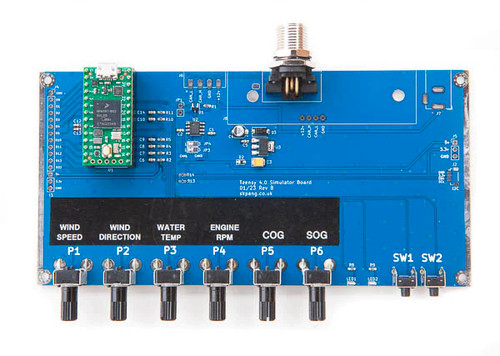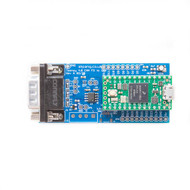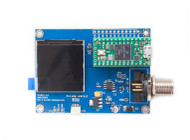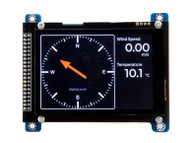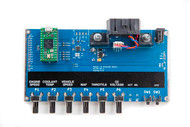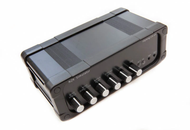Product Description
Free Shipping Within the United States!
The NMEA 2000 Simulator is a versatile tool for developers and technicians working with marine electronics. At its core, it utilizes the powerful Teensy 4.0 microcontroller, which comes pre-installed and pre-programmed with specialized simulator firmware. This compact, bench-top device is ideal for testing NMEA 2000-compatible equipment without requiring live data from an actual vessel.
By simulating real-world marine conditions and sensor outputs, the device allows for comprehensive diagnostics, validation, and troubleshooting of marine electronics such as chartplotters, engine monitors, and autopilot systems. It is particularly useful in R&D labs, product demonstrations, and technical support environments.
Simulation and PGN Control
The simulator generates a set of predefined Parameter Group Numbers (PGNs) — the unique identifiers used in NMEA 2000 messaging. These PGNs are essential for transmitting different types of data over the CAN-based NMEA 2000 network.
This unit enables interactive control over eight PGNs, offering both real-time variability and fixed value toggling:
-
Six PGNs are linked to rotary potentiometers, allowing analog adjustment of their data fields. For example, as the user rotates the knob, the simulated value for wind speed or engine RPM changes accordingly.
-
Two PGNs are controlled by onboard push-buttons, suitable for toggling digital states such as engine status or heading lock.
The currently supported PGNs include:
-
PGN 130310 – Environmental Parameters (e.g., Water Temperature): Simulates real-time changes in seawater temperature, allowing you to test temperature-sensitive systems such as chillers or alarms.
-
PGN 130306 – Wind Data: Adjusts wind speed and direction to evaluate performance of instruments like wind gauges or sailing computers.
-
PGN 127488 – Engine Parameters, Rapid Update: Sends live engine RPM values, useful for validating engine monitoring displays and alarms.
-
PGN 129026 – COG & SOG, Rapid Update: Simulates course over ground and speed over ground to test navigation and autopilot systems.
The firmware is open-source, giving developers the flexibility to customize or expand the set of PGNs. Additional data types—such as fuel flow, heading, or AIS targets—can be added with minor code modifications. This openness makes the device suitable for both basic functionality checks and complex system development.
Technical Features
-
Teensy 4.0 Microcontroller (installed and preloaded with firmware)
-
CAN Bus communication at 250 kbps, fully compliant with NMEA 2000 protocol
-
6x analog potentiometers for variable PGN control
-
2x push-buttons for digital input simulation
-
Micro-C connector for NMEA 2000 network interface
-
2x status LEDs for power and activity indication
-
Open-source firmware, written in Arduino-style code for easy expansion
What You Can Do With It
-
Test and validate third-party marine sensors, displays, and systems
-
Simulate dynamic marine data for software development
-
Perform diagnostics in a lab or tech support setting without needing to be on the water
-
Train staff and end users in interpreting NMEA 2000 data streams
-
Extend the firmware to simulate your own custom or proprietary PGNs
About NMEA 2000
NMEA 2000 is a robust, plug-and-play networking standard developed by the National Marine Electronics Association (NMEA). It supports bi-directional data exchange among multiple marine instruments and systems. The physical and data link layers are based on CAN (Controller Area Network) technology, widely adopted for its reliability and efficiency in harsh environments.
Typical data types carried over NMEA 2000 networks include:
-
GPS position and navigation
-
Wind and weather conditions
-
Engine diagnostics and fuel usage
-
Depth, temperature, and speed-through-water
-
Battery voltage and current
The standardized communication model allows devices from different manufacturers to seamlessly interact, provided they adhere to the NMEA 2000 specification.
This NMEA 2000 simulator enables safe, repeatable testing and is a valuable resource for any marine electronics developer or integrator.
 Advanced Marine Electrics and Electronics Troubleshooting
Advanced Marine Electrics and Electronics Troubleshooting
Whether you are a marine electronics professional or a boat owner, Advanced Marine Electrics and Electronics Troubleshooting helps you understand the new, more powerful methods of troubleshooting marine electrical and electronic systems.
A modern boat’s sophisticated installations and networked electronics can stretch the traditional diagnostic methods based on trouble lights and multimeters past their useful limits.
This book will show you how to:
- Use microprocessor-based diagnostic tools and techniques from the automotive and communications sectors, adapted for boats for the first time
- Diagnose the most difficult AC and DC problems
- Protect communications and navigation electronics from interference and lightning
- Seek out and eliminate stray-current sources and galvanic corrosion
 Loading... Please wait...
Loading... Please wait...

